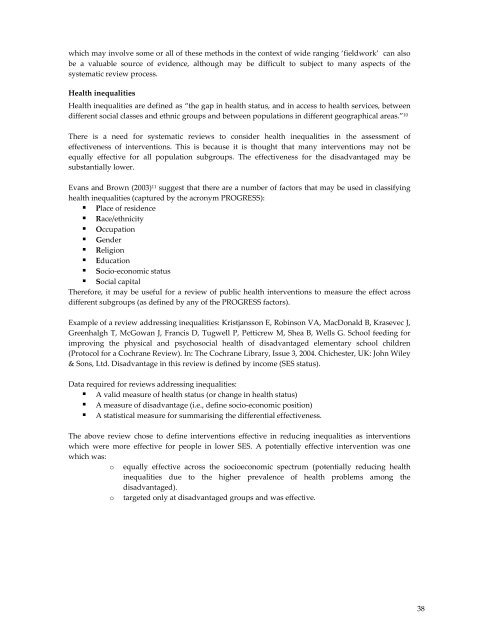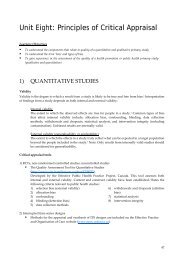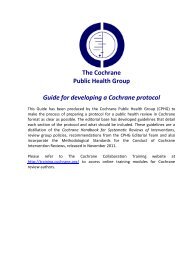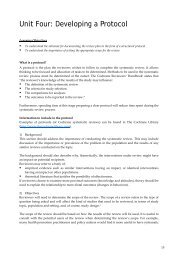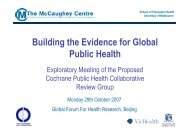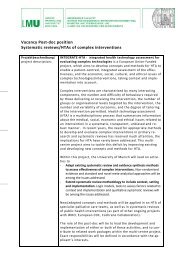Train the Trainer Course book - Cochrane Public Health Group
Train the Trainer Course book - Cochrane Public Health Group
Train the Trainer Course book - Cochrane Public Health Group
Create successful ePaper yourself
Turn your PDF publications into a flip-book with our unique Google optimized e-Paper software.
which may involve some or all of <strong>the</strong>se methods in <strong>the</strong> context of wide ranging ‘fieldwork’ can also<br />
be a valuable source of evidence, although may be difficult to subject to many aspects of <strong>the</strong><br />
systematic review process.<br />
<strong>Health</strong> inequalities<br />
<strong>Health</strong> inequalities are defined as “<strong>the</strong> gap in health status, and in access to health services, between<br />
different social classes and ethnic groups and between populations in different geographical areas.” 10<br />
There is a need for systematic reviews to consider health inequalities in <strong>the</strong> assessment of<br />
effectiveness of interventions. This is because it is thought that many interventions may not be<br />
equally effective for all population subgroups. The effectiveness for <strong>the</strong> disadvantaged may be<br />
substantially lower.<br />
Evans and Brown (2003) 11 suggest that <strong>the</strong>re are a number of factors that may be used in classifying<br />
health inequalities (captured by <strong>the</strong> acronym PROGRESS):<br />
Place of residence<br />
Race/ethnicity<br />
Occupation<br />
Gender<br />
Religion<br />
Education<br />
Socio-economic status<br />
Social capital<br />
Therefore, it may be useful for a review of public health interventions to measure <strong>the</strong> effect across<br />
different subgroups (as defined by any of <strong>the</strong> PROGRESS factors).<br />
Example of a review addressing inequalities: Kristjansson E, Robinson VA, MacDonald B, Krasevec J,<br />
Greenhalgh T, McGowan J, Francis D, Tugwell P, Petticrew M, Shea B, Wells G. School feeding for<br />
improving <strong>the</strong> physical and psychosocial health of disadvantaged elementary school children<br />
(Protocol for a <strong>Cochrane</strong> Review). In: The <strong>Cochrane</strong> Library, Issue 3, 2004. Chichester, UK: John Wiley<br />
& Sons, Ltd. Disadvantage in this review is defined by income (SES status).<br />
Data required for reviews addressing inequalities:<br />
A valid measure of health status (or change in health status)<br />
A measure of disadvantage (i.e., define socio-economic position)<br />
A statistical measure for summarising <strong>the</strong> differential effectiveness.<br />
The above review chose to define interventions effective in reducing inequalities as interventions<br />
which were more effective for people in lower SES. A potentially effective intervention was one<br />
which was:<br />
o equally effective across <strong>the</strong> socioeconomic spectrum (potentially reducing health<br />
inequalities due to <strong>the</strong> higher prevalence of health problems among <strong>the</strong><br />
disadvantaged).<br />
o targeted only at disadvantaged groups and was effective.<br />
38


